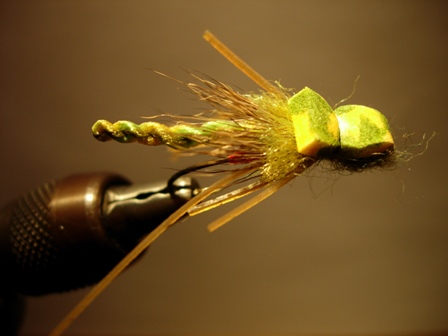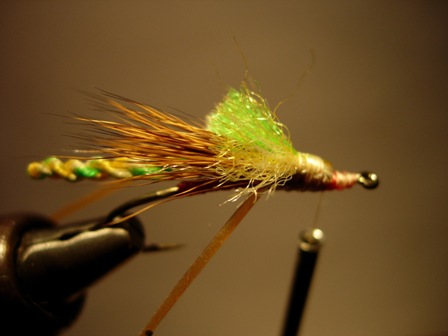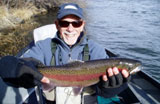|

Ken Hanley's Pygmy Hopper |
Materials:
|
|
Hook:
|
Daiichi 1260, 1270, or
similar bent long shank
hook, sizes 6-8 |
|
Thread |
Camel colored 6/0 or 8/0 |
|
Tag:
|
Red super floss or silk |
|
Abdomen:
|
Furled spooled antron
yarn: three strands—tan,
green, and gold |
|
Under-wing:
|
Natural deer hair |
|
Over-wing: |
Butts of furled antron
yarn |
|
Thorax:
|
Dubbed tan Buggy Nymph |
|
Long Kicker
Legs:
|
Silli-legs, pumpkin/blue
black or similar color |
|
Front Legs:
|
Same as kicker legs |
|
Head: |
3mm foam, white, colored
to desired tone |
|
|
Description
I had planned on featuring the October
Caddis emerger pattern for October. Instead
I decided to write about my friend Ken
Hanley’s Pygmy Hopper. I first saw Ken tie
this beauty a couple of years ago at one of
the fly fishing shows. He gave me one and
I’ve kept it ever since. Ken, Andy Guibord
and I recently did some Smallmouth Bass
fishing on the North Fork of the American
River just above Clementine Lake, and at
Yankee Jim’s bridge. Ken was using his
hopper, and gave me one to try. The action
of the fly is excellent: it floats in or
just under the surface film (as a real
hopper would), and the “kicker” legs move
enticingly. Andy caught the nicest fish of
the day on a Pygmy Hopper, and I landed a
few small fish most of which took the
hopper. The fishing was slow, but we had a
great time trying different approaches and
flies.
The Pygmy Hopper is relatively simple to
tie, and has no exotic materials. So crank
out a few of these and enter your best in
the monthly contest at the November meeting.
I’ll be tying the hopper at the October
meeting, so if you have any questions you
can resolve them there. Also, to see color
pictures of each step of the tying
instructions, visit Granite Bay Flycasters’
web site and click on “Fly Tyer’s Corner” on
the home page.
Tying Instructions
|
|
1. Smash the hook barb unless you are using
a barbless hook. Cover the front 2/3 of the
hook with the red superfloss or silk to form
a “tag.” Cover the wraps with a coat of
Flexament.
2. Cut three pieces of antron yarn (one
strand each color) from the spools. The
strands should be about 6” long. Even them
up and “furl” them, following the
instructions set out in the March,
2005 Fly Tyer’s Corner Leader
article. You can find it on the following
page from on the Granite Bay Flycasters web
site:
http://www.gbflycasters.org/fly%20tying/2005/FlyArchive2005.htm.
3. Tie in the furled abdomen at the midpoint
of the shank and wrap forward to about the
1/3 point on the shank. Place some Flexament
on the tie-in area. Don’t trim the butts of
the antron yet, as they will become the
over-wing. |
 |
|
|
|
|
4.
Using a long (6”) piece of the leg material, double it over and tie it in on top
of the furled antron so that it forms the kicker legs, which stick out to the
rear of the fly. The tie-in point should be at the same midway point on the
shank as you used to tie in the antron. They should be pulled down to the sides
of the hook and aligned in that manner. Don’t trim them yet |
 |
|
|
|
|
5. Cut, clean and stack a small bunch of
deer hair. Trim the butts so that the bunch
is around 1/2” long. Tie it in on top of the
tied-in antron; don’t allow it to slide
around to the bottom of the hook; it should
just splay out over the top of the hook.
Place a drop of Flexament on the wraps.
6. To form the over-wing, pull the antron
butts back over so they face the rear, and
tie them down on top of the deer hair; trim
the antron to the length of the deer hair or
a tad shorter. It helps to comb out the
butts before undertaking this step. Tie down
the over-wing and apply a drop of Flexament.
|
 |
|
|
|
|
7. Tie in a set of front legs at the 1/3
point on the shank, so that there are two
“legs” on each side of the hook. They will
be in an “X” configuration; take the
front-facing legs and pull them back,
securing them in that position so that all 4
of the front legs are facing rearward along
the sides of the shank.
|
 |
|
|
|
|
8. Tie in a piece of foam cut to about 3/8”
in width. Before doing so, trim the end to
be tied in to a “V” shape. With the point of
the V facing rearward and the rest of the
strip sticking out over the eye of the hook,
tie the foam in securely keeping it on top
of the hook and wrapping over it right to
the eye of the hook. Apply a drop of
Flexament.
|
 |
|
|
|
|
9. Dub a nice full thorax over
the top of the tied-in foam. Pull the foam over the top of the thorax, tie it
down at the rear of the thorax, and trim it so that you leave a stub about 1/8”
long. Trim the front legs to about a 1” length, and the kicker legs to about a 1
½” length.
|
 |
|
|
|
|
10. Whip finish at the point
where you tied down the pulled-over foam, and apply a drop of superglue to the
thread wraps on the underside of the fly. You can use permanent markers to vary
the color of the foam; a nice “camo” look seems to work well.
|
 |
|
|
|
|
Tying
Tips
1. When working with foam it is helpful to
use a nylon thread to avoid cutting the foam
when tying it down. Just before tying it
down, twirl the bobbin clockwise; this
results in a flat thread surface.
2. It also helps to grab the
foam just behind the tie-in point and squeeze it together; you will get a better
tie-in and avoid cutting the foam.
Fish the Pygmy Hopper for
trout, smallies, black bass, and panfish. Remember that trout look for hoppers
at the edges of the stream, and not out in the middle. |
|
|
|
|
 |
|

